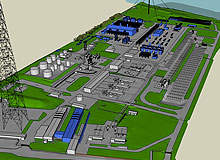
The Baird Gas Storage Project was proposed for conversion of the Baird gas field into an offshore gas storage facility. The partially depleted Baird field reservoir is located 86km off the coast of North Norfolk. The project would convert the reservoir into a facility to store gas from the UK National Transmission System (NTS).
Onshore planning permission for the project owned by Centrica (70%) and Parenco (30%) was given by the North Norfolk District Council in July 2010. Front-end engineering (FEED) of the onshore facilities was also completed. An application seeking permission to develop the offshore facilities was submitted in February 2010.
The project was expected to be completed by 2013, but in September 2013 Centrica announced its decision to shelve the project after the UK Government ruled out subsidies for new gas storage projects in the country.
The facility was expected to be the second largest gas storage facility in the UK with a capacity of 81bn cubic feet. It would have added about one third to the UK’s current gas storage capacity. The estimated life of the project was 50 years.
Construction and infrastructure
The Baird reservoir was planned to be converted into a storage facility by drilling up to 14 development wells.
A storage platform was planned as a normally unmanned installation (NUI).The NUI was to be designed as a four legged skirt pile driven jacket with 18 well slots. It was planned to be tied back to the Bacton gas terminal through a new 38in diameter bi-directional pipeline. A 100km-long Mono Ethylene Glycol line was also scheduled to be installed as part of the project.
The onshore facilities at the Bacton terminal were to include a new compressor station and other utilities.
The utilities planned were reception facilities, three gas turbine driven compressors and gas dehydration facilities. A heater package, Mono Ethylene Glycol (MEG) storage and regeneration facilities and a vent stack were also part of the utilities.
Engineering works for the project were expected to be carried out between 2010 and 2011. Construction works at the beach near the terminal (to connect to the pipeline) were planned to be carried out during 2011-12. Construction of the compressor station and other utilities were also scheduled to be carried out during 2011-13. But until 2012, the project was under review and no important physical works were undertaken.
Reserves
With the gas production from the United Kingdom Continental Shelf (UKCS) steadily declining, it was predicted that the UK would import 47% of gas needed for the country between 2010 and 2011. This was expected to rise to 72% during 2016-2017.
Demand for gas in the UK varies during summer (200m³/d) and winter (400m³/d). Increasing dependence on gas imports affects the security of supply for the UK during these periods of varying demand.
During peak periods of demand, lack of sufficient security of supply could affect supplies to consumers. The Baird project was expected to secure future energy supplies and maintain reliable supplies to consumers.
When demand is low, gas was to be stored in the Baird facility and extracted during the period of peak demand. The extracted gas was planned to be sent to the Bacton gas terminal complex via the new pipeline. At the Bacton terminal, gas was planned to be compressed and processed, and supplied to consumers through the NTS.
Partners
The project was to be built by Centrica Storage and Perenco UK. Centrica acquired 70% interest in the project from Perenco in February 2009.
Perenco owned the remaining 30% interest in the project. The companies had formed a joint venture called Bacton Storage Company to operate the facility when completed.
Centrica was responsible for the design and development of the project.
Contractors
The FEED study was carried out by Genesis Oil and Gas Consultants in London.
In July 2010, ESR Technology was awarded the contract for providing safety support services for onshore and offshore facilities of the project. ESR was appointed to provide services such as safety review and risk assessments for onshore and offshore facilities during the FEED study.
The company’s scope of work also was to include hazard identification, operability study and a safety integrity level study.

